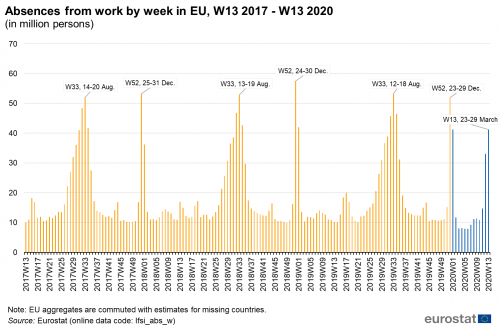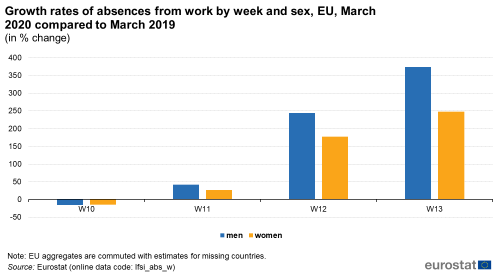Archive:Weekly absences from work
Data extracted in July 2020
Planned article update: October 2020
Highlights
Tweet Text
Tweet Text
To respond to the need for a more thorough analysis of the labour market in the situation of the recent COVID-19 pandemic, Eurostat developed new experimental indicator - “Weekly absences from work”. The indicator represents the number of absent from work employed persons in the surveyed reference week.
The following article is focused on the weekly absences from work and complements the article Absences from work - quarterly statistics, part of the publication Labour market in the light of the COVID-19 pandemic.
Full article
Weekly absences over the time
As shown in Figure 1, weekly absences from work in EU usually have peaks in the 33rd and 52nd week of the year, corresponding to mid-august and late December. However, from the second week of March (11th since the beginning of 2020), associated with the first confinement measures against the spread of COVID-19 pandemic taken by the governments, weekly absences sharply increased. People absent from work were 10.8 million at the beginning of March (week 10, 2020), their number increased to 14.7 million in the week after, and doubled its size in mid-March (week 12, 2020) when reached 33.1 million. At the last week of the month (week 13, 2020) weekly absences from work amounted for more than three quarters of the last year’s peaks from mid-august and late December and reached 41.2 million.

Source: Eurostat (lfsi_abs_w)
Figure 2 compares absences from work in EU in the first 13 weeks of 2020 to the average of the corresponding weeks in the period 2015-2019. It is visible that the amount of weekly absences in January, February and early March 2020 (weeks 1 to 10, 2020) is very similar, or even smaller, compared to the previous years. However, the last three weeks of March 2020 (weeks 11 to 13, 2020) differentiate significantly. Absences from work in the 11th week of 2020 were with 3.9 million more compared to the previous week and with one third (35.7 %) more compared to the average of the same period for the last five years. In the following two weeks, absences continued to increase and tripled this average. In weeks 12 and 13 of 2020 (mid to late March), people absent from work were respectively with 21.4 and 28.5 million more, compared to the same period in the previous years.

Source: Eurostat (lfsi_abs_w)
Figure 3 aims to describe the development of absences from work for men and women by comparison March 2020 to March 2019. During the first week of March (week 10, 2020), absences from work recorded a decrease in comparison the same period in 2019. The decrease was equal to 16.1 % for men and 14.9 % for women. The situation for both sexes started to differ after. During the second week of March (week 11, 2020) absences from work increased with 41.3 % for men and 26.9 % for women. The increase in the next two weeks was even larger. Women absent from work in the last two weeks of March (week 12 and 13, 2020) were three times more in comparison to the absent women during the same period of 2019. More precisely, their number amounted for 6.2 and 6.0 million respectively for the last two weeks of March 2019, compared to 17.3 and 20.8 million for the same weeks of 2020. Absent from work men increased three times in the 12th week of 2020, compared to the relevant week in 2019, or their number rose from 4.6 to 15.9 million. The largest increase was recorded for men in the last week of March (week 13, 2020), when the number of absent from work men was five times more, compared to the corresponding period from the previous year, or 20.4 million compared to 4.3 million.

Source: Eurostat (lfsi_abs_w)
Looking at the breakdown by sex of the weekly absences from work in EU in the first 13 weeks of 2020, it is visible that, with exception of the first week, women outnumbered men (Figure 4). This could be seen most prominently in late February and the beginning of March (weeks 9 and 10, 2020) when women were with around 50 % more than men were. However, after this period, the numbers of men and women among absent from work began to equalize and by the end of March (week 13, 2020), women surpassed men with much smaller margin - 2.4 %.
Weekly absences, country differances
All EU Member States for which data are available experienced a rise of weekly absences from work in the last few weeks of March 2020. However, this rise did not start from the same week for all countries. If Figure 2 is reproduced per each country, would be noticeable that in the majority, weekly absences started to increase steeply from the second or third week of March (weeks 11 or 12, 2020). Slovakia and Spain are given as examples in Figures 5 and 6.
In Slovakia (Figure 5), with the exception of the beginning of January and late February (weeks 1 and 8, 2020), absences from work followed the pattern from the previous five years. From the second week of March (week 11, 2020) on, their number began increasing significantly, both in comparison to the preceding weeks since the beginning of 2020 and to the average of the corresponding weeks of 2015-2019. At the end of March 2020 (week 13, 2020), 1.0 million people were absent from work in Slovakia, compared to the beginning of March (week 10, 2020) this number rose by 0.9 million. For contrast, the average number of absent from work people in Slovakia in the last week of March for the previous five years had been 91.3 thousand.

Source: Eurostat (lfsi_abs_w)
In Spain (Figure 6), although the weekly absences since the beginning of 2020 were higher, their pattern followed those of the last five years. From mid-March (weeks 12, 2020), absences began recording major spike. In the second week of March (week 11, 2020), 1.1 million people were absent from work in Spain, this number increased four times by the next week and reached 4.5 million. The rise continued. At the last week of the month (week 13, 2020), absences accounted for 6.0 million people. Considering the average of the same period for the last five years, absences had accounted for 1.2 million.

Source: Eurostat (lfsi_abs_w)
Two Member States differentiate sensibly form the others in terms of the starting point of the increase of absences. Namely, the Netherlands and Italy.
The Netherlands is shown in Figure 7. In this country, the number of people absent from work saw an increase later in time compared to the other Member States, only in the last week of March (week 13, 2020). Absences from work in the Netherlands had been following closely the pattern of the last five years, with the exception the second week of January (week 2, 2020). Nevertheless, at the end of March (week 13, 2020) weekly absence from work increased with 65.3 % compared to the previous week and doubled its size in comparison to the average for the same period in the last five years. Absent from work people in the Netherlands reached 1.1 million in the last week of March 2020, or with 0.6 million more compared to the average of the same period in the past five years.

Source: Eurostat (lfsi_abs_w)
The situation in Italy differed significantly from the Netherlands. People absent from work in Italy began to increase exponentially their number already since the end of February 2020 (Figure 8). At the mid-February (week 8, 2020), 0.9 million Italian people were away from their jobs. This number almost doubled in the following week, reaching 1.6 million, and continued to increase until the end of March (week 13, 2020), when 8.2 million people were absent from work in Italy, or with around nine times more compared to the average of the absences for the same period in the last five years.

Source: Eurostat (lfsi_abs_w)
Source data for tables and graphs
Data sources
<description of data sources, survey and data availability (completeness, recency) and limitations>
Context
<context of data collection and statistical results: policy background, uses of data>
Direct access to
Main tables
- Title(s) of second level folder (if any)
- Title(s) of third level folder (if any)
Database
- Title(s) of second level folder (if any)
- Title(s) of third level folder (if any)
Dedicated section
Publications
Publications in Statistics Explained (either online publications or Statistical articles) should be in 'See also' above
Methodology
<link to ESMS file, methodological publications, survey manuals, etc.>
- Crime and criminal justice (ESMS metadata file — crim_esms)
- Title of the publication
Legislation
- Use Eur-Lex icon on the ribbon tool at the top of the statistical article to enter the year and reference of your regulation or directive.
- See example of what should be issued hereafter
- Regulation (EU) No 1013/2016
Visualisations
- Regional Statistics Illustrated - select statistical domain 'xxx' (= Agriculture, Economy, Education, Health, Information society, Labour market, Population, Science and technology, Tourism or Transport) (top right)
External links
Notes
<footnote text will be automatically inserted if reference tags are used in article content text (use reference icon on ribbon)>
[[Category:<Subtheme category name(s)>|Name of the statistical article]] [[Category:<Statistical article>|Name of the statistical article]]
Delete [[Category:Model|]] below (and this line as well) before saving!
